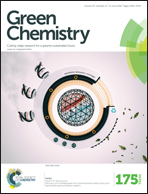In situ synthesis of cotton-derived Ni/C catalysts with controllable structures and enhanced catalytic performance†
Abstract
Owing to the oxygen-driven hydrophilicity of the surface, cotton can absorb large amounts of aqueous solutions even at room temperature. We designed a facile two-step synthesis strategy that takes advantage of this property for in situ fabrication of Ni/C catalysts with well-dispersed Ni particles on the carbonized cotton fiber. By tuning Ni loading and calcination temperatures, the size and distribution of Ni particles on the catalysts can be controlled. The catalytic performance of the as-prepared Ni/C catalysts has been tested for the selective hydrogenation of o-chloronitrobenzenes. It is found that the Ni/C catalyst obtained under the optimized conditions (51 wt% Ni loading, calcined at 400 °C) exhibits the best performance, with a yield of 100% in 5 h even at a low H2 pressure of 0.5 MPa. This new synthetic method may pave a way for producing low-cost Ni/C catalysts from cotton on a large scale, which is attractive for industrial applications.


 Please wait while we load your content...
Please wait while we load your content...